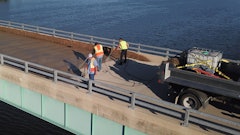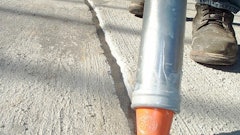
As a professional that’s concerned with the pavement business, you’re probably well aware of the detrimental effects water intrusion can have on pavement life.
Untreated cracks in pavement enable water and incompressible materials to enter the cracks, damage the base and destroy the pavement. Cracks in pavement can expand and contract due to temperature, moisture and traffic. As cracks move and debris such as sand and dirt enter, additional stress is caused and micro-cracking below the surface further weakens and deteriorates the pavement.
Crack sealing has long been a popular preventative measure to keep moisture out of the pavement, preventing potholes from forming and extending pavement life. Simply put, routed and sealed cracks are designed to perform better and to resist intrusion by water, impurities and incompressible materials. By adding crack routing to crack sealing efforts, you can help ensure those pavement preservation efforts will last up to twice as long.
Benefits to Pavement
In the same way that a dentist prepares a tooth before filling a cavity, crews must prepare cracks to receive sealants. The better the preparation, the better the chance that the sealant will have a longer service life and ultimately, extend the life of the pavement. Results from a recent Strategic Highway Research Program study showed that you can double sealant service life to perform more than 94 months if cracks are routed prior to sealing.
When sealant is applied to a crack that is not routed, the material is prone to being pushed up out of the crack when the pavement contracts in the warmer summer months. This leaves the sealant exposed to traffic to be worn away. This loss of sealant results in an inability to accommodate the crack expansion during the colder winter months. A routed crack has a reservoir of sealant that allows for seasonal expansion and contraction of the pavement movement, protecting the integrity of the sealant and extending its service life.
When sealant is applied into a routed reservoir, adhesion is improved and the sealant is better equipped to accommodate crack movement due to weather and traffic. Crack routing also allows the sealant level to remain below the surface of the pavement which protects the sealant from traffic and snowplow contact.
Benefits to Customers
As customers pay for services, they want to know they are going to get the most out of their investment. Crack routing can help achieve those long-term results customers are looking for.
Properly routed and sealed cracks remain sealed, reduce secondary crack development and reduce new crack development and spalling. The longer cracks stay sealed, the less your customer has to worry about moisture seeping in to their pavement and creating potholes.
Crack treatment is the lowest-cost pavement preservation treatment with the best benefit-to-cost ratio of AC pavement preservation treatments. Having a crack routing and sealing program gives customers the ability to right-size their budgets for early and routine treatments.
Crack routing and sealing achieves:
- Reductions in cracking distress
- Reduction in potholes and cracking from 75% to 1% of pavements within three years
- Increased pavement smoothness over a five-year period
- Reductions in raveling of pavement
Benefits to Contractors
The most expensive part of crack sealing is paying to have to seal that same crack again. Be sure your customers understand that.
Contractors who complete crack sealing work can tell their customers that properly sealed cracks can offer up to four years of protection. In comparison, cracks that are both routed and sealed offer up to seven years of pavement protection, thus almost doubling crack sealing efforts and giving the customers more bang for their crack sealing buck.
By offering crack routing to your customers, you’re providing them with properly prepared cracks that are 40% more likely to hold sealant and last almost twice as long. This also means you can also charge more money for your services.
Crack routing adds marginal cost to your business in comparison to other types of preservation treatments and significantly extends the service life of the pavement. With one additional piece of equipment – a router -- pavement maintenance contractors can add crack routing as a pavement preservation service that can bring in additional revenue and enhance the quality of their crack sealing efforts.
Bottom line: the longer a pavement performs, the more likely customers are to be happy with their investment in your services and repeat business with your company.



















![Patcher4 4edited[66]](https://img.forconstructionpros.com/files/base/acbm/fcp/image/2022/10/patcher4_4edited_66_.63602ddb9e727.png?auto=format%2Ccompress&fit=crop&h=135&q=70&rect=0%2C123%2C1920%2C1080&w=240)








